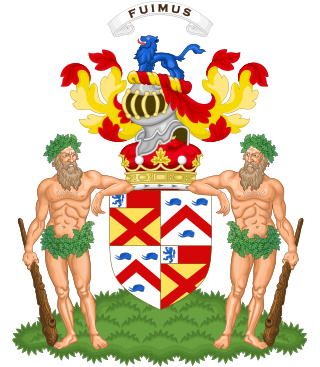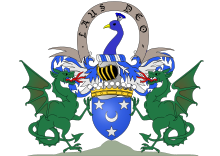
The title Duke of Abercorn is a title in the Peerage of Ireland. It was created in 1868 and bestowed upon James Hamilton, 2nd Marquess of Abercorn. Although the Dukedom is in the Peerage of Ireland, it refers to Abercorn, West Lothian, and the Duke also bears four titles in the Peerage of Scotland and two in the Peerage of Great Britain, and is one of three peers who have titles in those three peerages. The Duke of Abercorn also claims the French title of Duke of Châtellerault, created in 1548.

Earl of Sandwich is a noble title in the Peerage of England, held since its creation by the House of Montagu. It is nominally associated with Sandwich, Kent. It was created in 1660 for the prominent naval commander Admiral Sir Edward Montagu. He was made Baron Montagu of St Neots, of St Neots in the County of Huntingdon, and Viscount Hinchingbrooke, at the same time, also in the Peerage of England. The viscountcy is used as the courtesy title by the heir apparent to the earldom. A member of the prominent Montagu family, Lord Sandwich was the son of Sir Sidney Montagu, youngest brother of Henry Montagu, 1st Earl of Manchester, and Edward Montagu, 1st Baron Montagu of Boughton.

Marquess of Ailesbury, in the County of Buckingham, is a title in the Peerage of the United Kingdom. It was created on 17 July 1821 for Charles Brudenell-Bruce, 2nd Earl of Ailesbury.

Earl of Rothes is a title in the Peerage of Scotland. It was created in 1458 for George Leslie, 1st Lord Leslie. He had already been created Lord Leslie in 1445, also in the Peerage of Scotland. His grandson, the third Earl, having only succeeded his elder brother in March 1513, was killed at the Battle of Flodden on 9 September of the same year. His son, the fourth Earl, served as an Extraordinary Lord of Session. Lord Rothes was also tried for the murder of Cardinal Beaton but was acquitted.

Earl of Elgin is a title in the Peerage of Scotland, created in 1633 for Thomas Bruce, 3rd Lord Kinloss. He was later created Baron Bruce, of Whorlton in the County of York, in the Peerage of England on 30 July 1641. The Earl of Elgin is the hereditary Clan Chief of Clan Bruce.

Earl of Lauderdale is a title in the Peerage of Scotland. The current holder of the title is Ian Maitland, 18th Earl of Lauderdale.

Earl of Glasgow is a title in the Peerage of Scotland. It was created in 1703 for David Boyle, Lord Boyle.

Earl of the County of Mayo, usually known simply as Earl of Mayo, is a title in the Peerage of Ireland created, in 1785, for John Bourke, 1st Viscount Mayo. For many years he served as "First Commissioner of Revenue" in Ireland. He had already been created Baron Naas, of Naas in the county of Kildare, in 1776, and Viscount Mayo, of Moneycrower in the county of Mayo, in 1781, also in the Peerage of Ireland.

Viscount Mountgarret is a title in the Peerage of Ireland.

John Campbell Arbuthnott, 16th Viscount of Arbuthnott was a Scottish peer, Lord Lieutenant of Kincardineshire (1977–99) and a notable businessman.

Major General Robert Keith Arbuthnott, 15th Viscount of Arbuthnott, was a senior British Army officer who served in both the First World War and the Second World War.

John Arbuthnott, 8th Viscount of Arbuthnott DL FRSE was a Scottish peer and soldier. Known as "the rich Lord" he built the bridge in front of Arbuthnott House, Kincardineshire. He was the first member of the family who consistently spelled his name "Arbuthnott" rather than "Arbuthnot".

Robert Arbuthnot, 1st Viscount of Arbuthnott PC was a Scottish Peer and Scottish Privy Counsellor (1649).

Clan Arbuthnott is a Lowland Scottish clan.
The heir apparent or heir presumptive to a Scottish peerage is known as a Master, or a Mistress if the heir is female. The heir's style is "The Master of [Peerage]" or "The Mistress of [Peerage]".

Sir William Arbuthnot, 1st Baronet of Edinburgh FRSE was a Scottish landowner and politician. He served as Lord Provost of Edinburgh and Lord Lieutenant of the City of Edinburgh.
Alexander Arbuthnot was appointed a Baron of the Court of Exchequer in Scotland after the Union of England and Scotland in 1707.

John Alves Arbuthnot of Coworth House was a British banker, co-founder of Arbuthnot Latham, a private bank.

Anthony Adrian Keith-Falconer, 5th Earl of Kintore, 5th Lord Keith of Inverurie and Keith Hall, who was known as the 7th Lord Falconer of Halkerton, between 1776 and 1778, was a Dutch-Scottish aristocrat.
The Arbuthnot baronetcy of Edinburgh' was created in the Baronetage of the United Kingdom on 3 April 1823 for Sir William Arbuthnot, Provost of Edinburgh.












